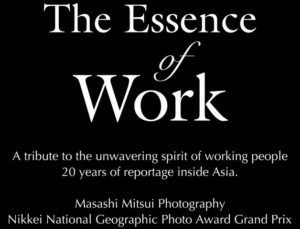Exhibition

Statement
I rent a motorcycle locally riding from town to town without a fixed destination or even a map. There is no telling where I will go next. With minimum preparation, I let myself be guided by chance, and I really enjoy the encounters that result from it. So far, I have visited thirty nine countries, mostly in Asia. I have been to India alone seven times, exploring all corners of the country. To date, I have ridden well over 70,000 miles.
During the course of these travels, I have been most drawn to working people such as farmers, fishermen, blacksmiths and brick factory workers. Their kind of work does not require the special skills needed by a traditional craftsman. Instead, it is work that is mostly simple and physical, and often taken for granted. But I find these people beautiful. Working in the sweat of their brow, they have a fundamental human vitality—as though telling us that people have different roles in life, and that the essential meaning of “work” is to engage in those roles and carry them out with sincere good will.
In India, where social norms are traditionally based on kinship and village communities, children used to inherit the occupations of their parents. However, with rapid economic growth and globalization, this way of life is undergoing major transformations. Occupations once in demand are no longer needed, while new jobs are being created one after the other. For example, one of the dye factories I photographed in 2016 has since ceased operation and all its employees have been dismissed. It was a complete ruin when I revisited it the following year.
One by one, the workers whose occupations have been handed down through generations are losing their roles in society. It is an accelerating trend that no one can alter. There is no guarantee that a currently existent job will be around in ten years. Here is all the more reason for me to photograph these working people.
In the not-so-distant future, we will forget that such jobs even existed. Before that happens, I want to foster awareness of these workers, to document in my photographs their labor and sweat, the earnest look in their eyes, as well as the grace of their bodies. I also hope to make the public more appreciative that work which is often overlooked because of its humdrum character makes an essential contribution to the world, without which it would not exist as it does. Bringing it to the fore is what I consider my role as a photographer to be.
Squeeze red
A worker at a dye factory is compressing a bundle of strings that has been dyed red. In the concentrated movement of the man dedicated to his work, I was aware of an inner glow that seemed to emanate from him. They say that these threads will be used to weave brightly colored fabrics, and that the fabrics will be sold not only domestically, but also shipped overseas to countries in the Middle East and Africa. These factories, whose manufacturing process is entirely dependent on manual labor, do not seem untouched by the waves of globalization. (Tamil Nadu, India 2015)
Journey of the shepherd
A shepherd called Diru, whom I met on the plains of Gujarat state in western India, was dressed in white indigenous garb, wearing a white knit cap, and leading a flock of about 200 sheep. The shepherds were living in their own time, which flowed in as leisurely a fashion as the clouds across the sky, harnessing the powers of nature. Without relying on modern devices, they grasped naturally all the information needed to find grassland and water. (Gujarat, India 2018)
Colorful Pattern
These craftsmen are hand printing a pattern on fabric for sari, a traditional Indian garment. A stencil screen is placed over a fabric, which is fixed to a board; then they force the ink through the screen with the pressure of their arms to transfer the design. The work requires precision and physical strength. In recent years, an increasing number of factories are adopting machine printing. However, it is said that hand printing remains more efficient for making products in small batches, as well as for printing on thin fabrics. (Gujarat, India 2016)
land of Rohingya
I saw people working with dignity and pride even in harsh conditions, as they calmly tilled the fields and sowing seeds. Though facing an unreasonable situation and poverty, they carried on whatever they were demanded of them. “Both my father and grandfather have tilled this soil,” a Rohingya villager told me. “Someday, my children and grandchildren will too. This is our home, and we are not leaving, no matter what anyone tells us.” (Rakhine, Myanmar 2017)
